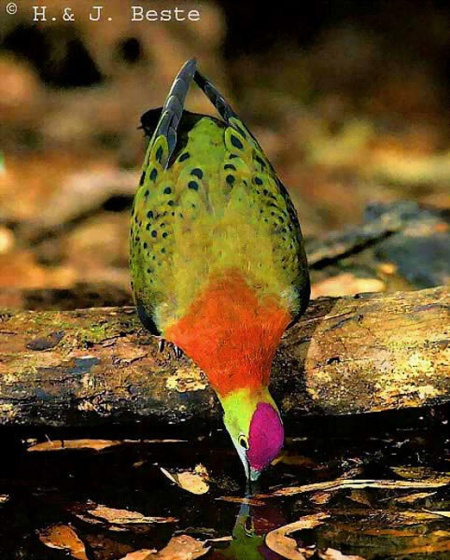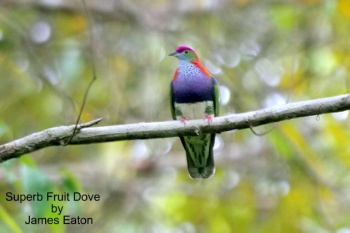Includes: Eastern Superb Fruit Dove, Western Superb Fruit Dove
- Ptilinopus superbus
Identification
21-24 cm (8¼-9½ in) Male
- crown purple
- hindneck orange
- upper breast grey
- breastband bluish-black separating upper breast from underparts
- underparts white or whitish
- Remainder of body green
- undertail coverts green with pale edges
- tail green with grey tip
- eyes and eye rings yellow
Female
- overall plumage green
- upper wing coverts with more or less prominent yellow edging
- breast grey
- underparts white
- crown with smallish purple patch (temminckii)
- nape with black patch (superbus)
Young birds resemble females but lack the purple crown/black nape patch.
Distribution
Australia, north-eastern Queensland to north-eastern New South Wales, New Guinea, Solomon Islands, the Philippines and Sulawesi.
Taxonomy
Subspecies may be split as "Eastern Superb Fruit Dove", P. superbus (ssp. superbus) and "Western Superb Fruit Dove", P. temminckii (temminckii) [2].
Subspecies
Clements recognises the following subspecies [1]:
- P. s. temminckii: "Western Superb Fruit Dove". Sulawesi and Sula Islands. [Male with extensive belly purple and yellowish wash to white underparts. Female with purple crown spot.]
- P. s. superbus: "Eastern Superb Fruit Dove". Moluccas to Bismarck Archipelago, Solomon Islands and north-eastern Australia. [Male with reduced belly purple and (pure) white underparts. Female with black nape spot]
Habitat
Found in a variety of forest types, including mangroves and forest edges and more open areas with scattered trees.
Behaviour
Arboreal.
Diet
Their diet consists of fruit, particularly figs, and berries.
Breeding
The nest is a flimsy platform of twigs built in bushy trees from 5-30 m above the ground. The female incubates the eggs at night while the male incubates by day.
References
- Clements, J. F., T. S. Schulenberg, M. J. Iliff, D. Roberson, T. A. Fredericks, B. L. Sullivan, and C. L. Wood. 2017. The eBird/Clements checklist of birds of the world: v2017, with updates to August 2017. Downloaded from http://www.birds.cornell.edu/clementschecklist/download/
- Eaton, JA, B van Balen, NW Brickle, FE Rheindt 2021. Birds of the Indonesian Archipelago (Greater Sundas and Wallacea), Second Edition. Lynx Editions. ISBN978-84-16728-44-2
Recommended Citation
- BirdForum Opus contributors. (2024) Superb Fruit Dove. In: BirdForum, the forum for wild birds and birding. Retrieved 27 July 2024 from https://www.birdforum.net/opus/Superb_Fruit_Dove






